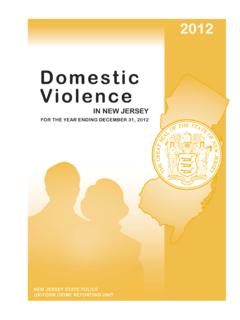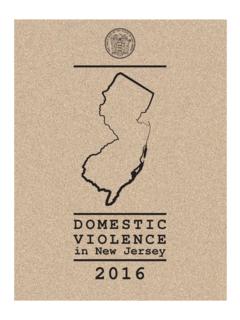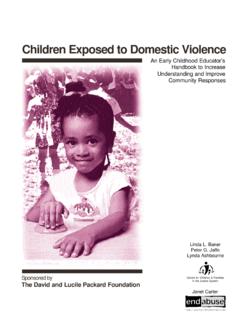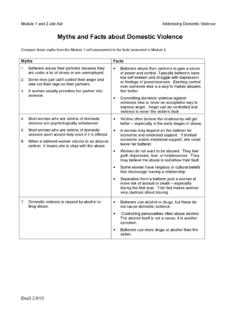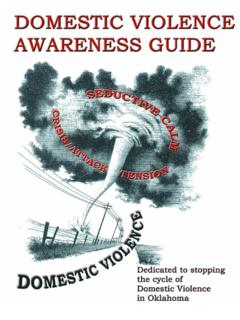Transcription of A guide for practice when responding to children exposed ...
1 A guide for practice when responding to children exposed to domestic violenceThis guide for practice is one of the results of the Honor Our Voices project, a collaborative effort of the Avon Foundation for Women and two centers at the University of Minnesota: the Minnesota Center Against violence and Abuse (MINCAVA) and the Center for Advanced Studies in Child Welfare (CASCW). Honor Our Voices is a multi-faceted effort to increase the awareness and sensitivity of shelter advocates and other social service professionals to the needs of children exposed to domestic violence and to suggest promising ways of responding to these children s needs.
2 A major element of the Honor Our Voices project is an online training module that includes the stories of three children exposed to domestic violence and highlights the effects of domestic violence on children and the promising practices that may respond to these children at different ages. The online training module is freely available at A third result of our project is a free digital library of short audio programs that highlight specific promising practices through the voices of children . They can be found at on the Honor Our Voices website. Honor our citation: Edleson, , Nguyen, , Kimball, E.
3 (2011). Honor Our Voices: A guide for practice when responding to children exposed to domestic violence . Minneapolis, MN: Minnesota Center Against violence and Abuse (MINCAVA). Acknowledgements ..iiiIntroduction ..1 Key Issues and Promising practices ..2 Understand the effects of domestic violence on children ..2 Foster bonding among family members ..5 Create opportunities for mothers and their children to connect and bond with each an environment that fosters healthy sibling relationships..5 Promote healthy peer and adult role models ..6 Create a welcoming environment that supports everyday routines.
4 7 Provide support to help children maintain their prior policies and practices that promote co-locating of domestic violence shelter workers with teens ..8 Explore relationship with parents ..9 Understand the feelings and perceptions of children toward the abuser and their prior and current relationships ..9 Encourage children to express their feelings about the inconsistent behaviors they may observe at home and explain coercive or manipulating techniques that abusers use ..10 Develop safety plans ..11 Engage children in safety planning, explain to them what is happening, and understand their feelings and thoughts during this critical time.
5 11 Understand parentification of children ..12 Hear and respect children s voices as they have valuable ideas and opinions to contribute ..12 Understand the unique needs of teens ..13 Pay particular attention to the gender box that boys and girls are put in when they are growing up ..13 Equip mothers to talk with their teens about violence ..14 Promote teen-centered and teen-led activities ..14 Prevent teen dating violence and domestic violence ..15 Help teens acknowledge concerns about domestic violence and develop alternatives to violence ..15 Endorse community partnerships.
6 17 Form collaborative relationships between domestic violence advocates and child protection workers ..17 Train police in providing comfort and emotional support for children during crises ..18 Promote cross-collaboration among varied systems to effectively help children heal and reduce the stress of dealing with different systems separately ..19 Include supervised visitation center (SVC) staff as part of larger coordinated community responses to domestic violence ..19 Evaluate needs through the lifespan ..20 Provide opportunities for children and their mothers to continue to engage in healing.
7 20 Provide emotional and economic support for battered mothers so that they can provide appropriate care for their children ..21 Offer linkages for children and their families to supportive services throughout the lifespan ..21 Talk with children about their experiences at the shelter and determine any lasting needs or concerns before they leave shelters ..21 Cultivate informal supports ..22 Support battered women and their families in strengthening their social support networks ..22 Engage community opinion leaders in supporting non- violence ..22 Conclusion ..23 References.
8 24 Appendix A: The Roundtable meeting ..29 List of Roundtable Participants ..30 Appendix B: Additional resources ..31 Table oF Our Voices is the result of many contributors ideas about the experiences and needs of children exposed to domestic violence . We would like to thank the adult sur-vivors of childhood exposure who contributed both through an online survey and as participants in our National Roundtable. Foremost among them was Casey Keene, the VAWnet Manager at the National Resource Center on domestic violence , whose per-sonal story inspired this project. She shared both her expertise and personal experiences throughout the development of these materials.
9 We would also like to acknowledge Jim Henderson from the Battered Women s Justice Project and Ruby White Starr of the National Council of Juvenile and Family Court Judges for sharing their own stories and experiences at the National Roundtable. Their stories enriched the Roundtable discus-sions and were extremely helpful in the development of this project. We would also like to thank the Avon Foundation for Women for their support of this project. In particular, we owe a debt of gratitude to Christine Jaworsky, Manager of Grants and Programs at the Foundation, who believed in this project from the start and helped us both to refine our concept and widely distribute these results.
10 In addition, we would like to thank all of the National Roundtable participants who vol-unteered their time and contributed their knowledge and expertise to help identify key issues and promising practices in working with children exposed to domestic violence . We greatly appreciate the time they took from their busy schedules to attend the Round-table in December 2010 and their continuing review and feedback throughout the entire project. A list of all the National Roundtable participants appears in Appendix , Jeffrey L. Edleson, Ericka Kimball, and Hoa T. Nguyen were the primary staff that worked on this project.


